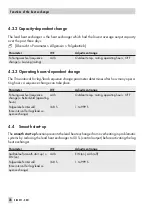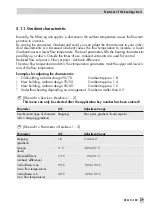
7.7
Three-step control
The control algorithm is adjusted separately for the control valves Rk1 to Rk3 of the heat
exchangers and for the heating circuit mixing valves HK1 to HK3.
The flow temperature can be controlled using a PI algorithm. The valve reacts to pulses that the
controller sends when a system deviation occurs. The length of the first pulse, in particular, de-
pends on the extent of the system deviation and the selected
Proportional gain K
P
(the pulse
length increases as K
P
increases). The pulse and pause lengths change continuously until the
system deviation has been eliminated. The pause length between the single pulses is greatly in-
fluenced by the
Reset time T
N
(the pause length increases as T
N
increases).
The
Transit time T
Y
specifies the time required by the valve to travel through the range of 0 to
100 %.
Heat exchanger control circuit Rk1 to Rk3
The control valves are connected to the binary outputs listed below:
4
BA3 and BA4 of the controller for heat exchanger control circuit Rk1
4
BA5 and BA6 of the controller for heat exchanger control circuit Rk2
4
BA1 and BA2 at ModBus I/O 1402-0328 (4) for heat exchanger control circuit Rk3
Note:
Alternative assignment is shown in section 8.1.
2
[Übersicht > Service > Wärmetauscher 1…3]
This menu can only be selected after the application key number has been entered!
Parameter
WE
Adjustment range
Regelkreis (control circuit)
= 3-Punkt (three-step)
3-Punkt
Continuous, three-step
2
[Übersicht > Parameter > Wärmetauscher 1…3]
Parameters
WE
Adjustment range
Kp
1.0
0.1 to 99.9
Tn
30 s
0 to 999 s
Ty
45 s
15 to 600 s
Heating circuits HK1 to HK3
The control valves are connected to the binary outputs listed below:
4
BA1 and BA2 to ModBus I/O 1402-0328 (1) for heating circuit HK1
EB 5571-2 EN
39
General functions
















































